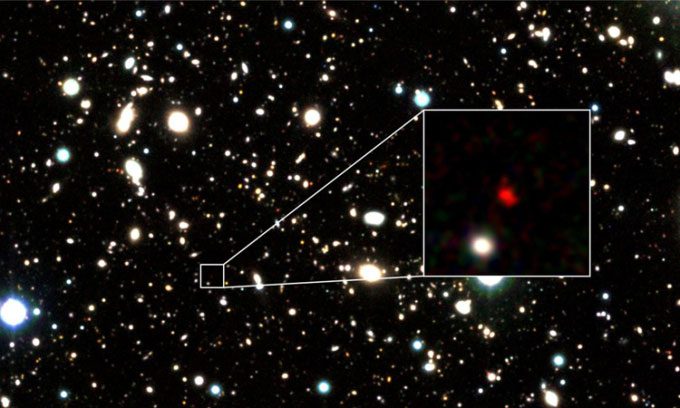The HD1 galaxy may contain a supermassive black hole weighing 100 million times that of the Sun or some of the oldest stars in the universe.
Researchers have discovered that object HD1 could potentially be the farthest astronomical object ever recorded. It is likely a galaxy located approximately 13.5 billion light-years from Earth, more than 100 million light-years farther than the current record-holding galaxy, GN-z11. This new finding was published in the Astrophysical Journal on April 7, alongside a related study in the Monthly Notices of the Royal Astronomical Society Letters.

HD1, the object that may be the farthest galaxy ever discovered. (Image: Harikane)
HD1 is particularly bright in ultraviolet light, indicating high-energy activity within the galaxy. As a result, scientists initially hypothesized that it could be a starburst galaxy—a type of galaxy that “produces” stars at a relatively rapid rate. However, upon further investigation, they found that it generates more than 100 stars each year, ten times faster than typical starburst galaxies.
The researchers proposed two new hypotheses to explain the immense energy emitted by HD1.
- First, it may contain a supermassive black hole weighing 100 million times that of the Sun at its center. If so, this would be the oldest black hole of this size ever observed.
- Second, HD1 may host some of the earliest stars formed in the universe.
“The first stars formed in the universe were larger, brighter, and hotter than modern stars,” said Fabio Pacucci, co-author of the study and an astronomer at the Harvard-Smithsonian Center for Astrophysics.
These stars are collectively known as Population III and are believed to produce significantly higher levels of ultraviolet light than ordinary stars. This could explain the brightness of HD1. If it can be proven that HD1 contains Population III stars, it would mark the first time astronomers have observed this type of star.
Scientists discovered HD1 after 1,200 hours of observations using the Subaru Telescope (Hawaii), the VISTA Telescope (Chile), the Infrared Telescope (UK), and NASA’s now-retired Spitzer Space Telescope, subsequently confirming its distance through observations collected by the ALMA telescope array (Chile). The research team will soon monitor HD1 using the James Webb Space Telescope to further validate their estimates.





















































